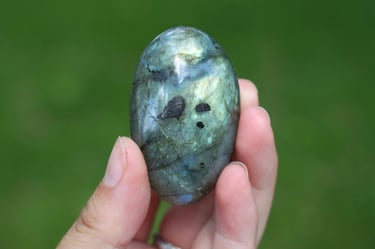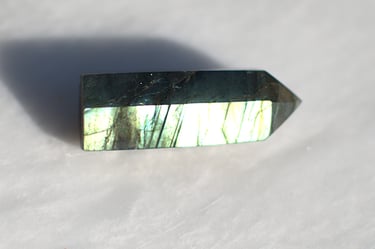Labradorite
Protection, transformation, intuition, mental clarity, self-discovery, shielding, confidence, spiritual awakening, insight, psychic abilities, creativity
Metaphysical Properties:
Labradorite is a powerful stone of transformation and protection, known for awakening intuition and shielding the aura. It stimulates the Third Eye, enhances psychic abilities, and supports spiritual exploration while keeping the wearer grounded. Ideal for navigating change, Labradorite brings clarity, boosts confidence, and reveals hidden truths, making it a trusted companion for personal growth and inner discovery.
Symbolism & Associations:
Labradorite symbolises the mysteries of the universe, the hidden truths within ourselves, and the magic that exists beyond the mundane. It is often seen as a stone of transformation, personal growth, and esoteric knowledge.
Chakra Alignment:
Labradorite primarily aligns with the Third Eye and Crown chakras, enhancing intuitive perception and spiritual insight.
Planets:
Uranus, Moon
Zodiacs:
Scorpio, Leo, Sagittarius
Elements:
Air, Water
Similar Stones:
Rainbow Moonstone, Silver Flash Larvikite, Opal, Nuummite
Correspondences:
Colours: Blue, grey, green, gold, purple, black
Flowers: Iris, Bluebell, Night Blooming Jasmine
Herbs: Mugwort, Sage, Eyebright
Essential Oils: Frankincense, Sandalwood, Mugwort, Clary Sage
Incense: Myrrh, Copal, Sandalwood
Metals: Silver, Platinum
Months, Days & Seasons: October, Wednesday, Autumn
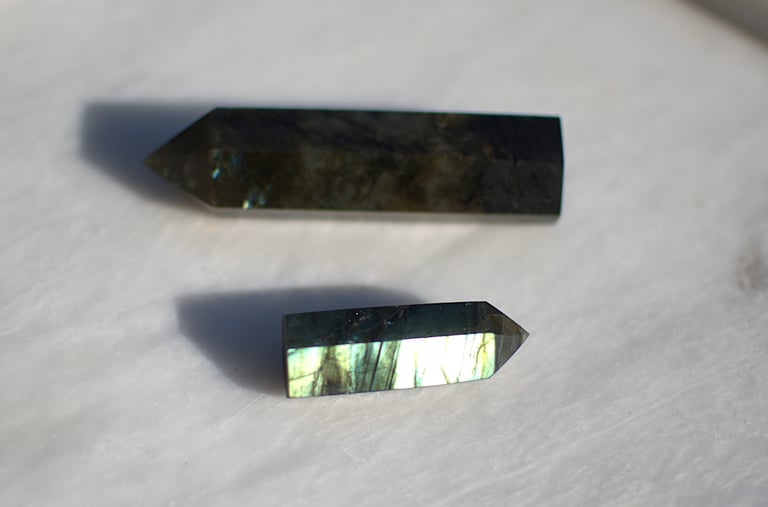


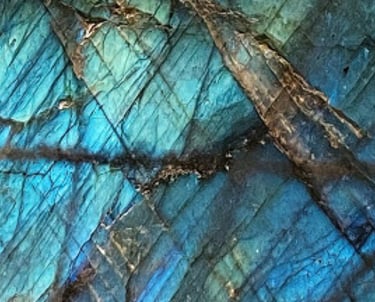
Facts
Stone Type:
Feldspar (specifically a plagioclase feldspar)
Hardness Rating:
6–6.5 on the Mohs scale – suitable for most jewellery, though it may scratch with rough wear.
Chemical Formula:
(Ca,Na)(Al,Si)₄O₈
Care Guide
Not suitable for salt or prolonged water submersion. Clean gently with a soft cloth. Store away from harder gemstones to prevent scratches. Avoid ultrasonic or steam cleaners.
Spiritual
Used in energy shielding, spiritual awakening, and deepening meditation. Enhances intuitive practices like divination and dreamwork, making it a popular choice for seers and energy workers.
Healing
Believed to support eye health, relieve anxiety and stress, regulate metabolism, and ease symptoms related to the respiratory system. Said to help with detoxification and bring light to hormonal imbalances.
Cleansing
Cleanse with sound (singing bowls, tuning forks), moonlight, incense, or visualisation. Avoid harsh methods like salt.
Affirmations
“I embrace the transformation within me.”
“My energy is protected, and my intuition is strong.”
“I trust my inner guidance.”
“I awaken to my full spiritual potential.”
Meditation
Hold during meditation to enhance third eye activity, or place on the forehead to enter a state of inner exploration. Use it to visualise energetic shields forming around the aura or when seeking inner guidance.
Astrology
Strongly linked to Scorpio and Sagittarius energy, Labradorite is ideal for deep introspection, rebirth, and mystical exploration. Its lunar connections also make it potent during celestial events like eclipses and new moons.
Vibration
Labradorite carries a high yet stable frequency that interacts with the subtle energy body to awaken latent psychic gifts, clear mental fog, and stimulate the higher mind. Its vibration creates a bubble of protection that allows the soul to explore freely while staying grounded.
Did You Know:
Labradorite was named after the Labrador Peninsula in Canada, where it was first discovered in 1770. Its magical flashes are known as “labradorescence,” a unique optical phenomenon caused by light interference within its internal structure.
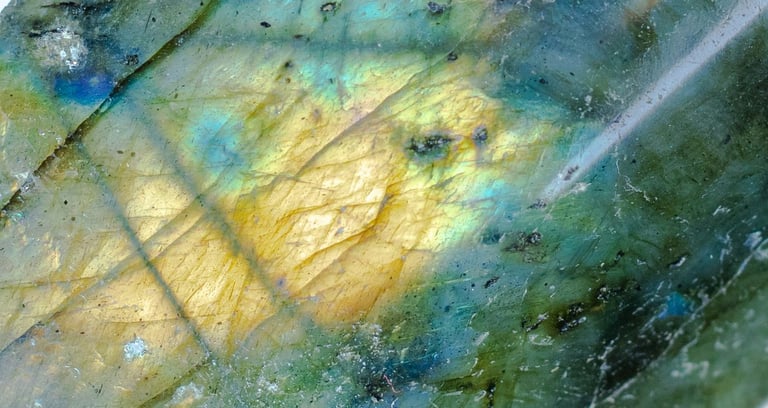

Mythology & Folklore
Labradorite's mythological roots run deep, especially within Inuit and other Northern cultures. According to Inuit legend, Labradorite fell from the frozen fire of the Aurora Borealis, and it was once believed that the Northern Lights were trapped inside the stone. A warrior, discovering the stone's glow, struck it with his spear to release the lights back into the sky. This vivid story reflects the stone’s deep spiritual symbolism and links to celestial energy.
In Finnish mythology, Labradorite has been associated with shamanic journeying and soul retrieval. The Finnish believed that the shimmering flashes in the stone, known as labradorescence, were a result of magical realms peeking through from other dimensions. Shamans used Labradorite in rituals to pierce the veil between this world and the spiritual plane.
In Norse tradition, Labradorite was sometimes connected to Bifröst, the rainbow bridge that connected Midgard (Earth) and Asgard (the realm of the gods). The stone's spectral flashes were interpreted as glimpses of divine passageways and interdimensional connections. This symbolic link added to its reputation as a powerful protector during spiritual travel.
Some Native American tribes viewed Labradorite as a magical stone that brought harmony and balance, especially during ceremonies and dreamwork. It was regarded as a keeper of ancient knowledge and a stone of the ancestors.
Tibetan folklore also mentions iridescent stones, thought to carry the wisdom of the heavens and help reveal one’s spiritual path. While not always named directly, stones fitting Labradorite’s appearance were used in meditative practices and believed to open the third eye.
Together, these diverse myths suggest a universal reverence for Labradorite as a bridge between the earthly and the mystical, reflecting its reputation as a stone of inner vision, transformation, and divine insight.
Historical Significance
Labradorite was officially discovered in 1770 on Paul’s Island, near the town of Nain in Labrador, Canada, by Moravian missionaries. However, local Inuit communities had been aware of the stone’s beauty and power long before its Western documentation. After its discovery, Labradorite was quickly adopted into European lapidary arts and became popular in jewellery during the 18th and 19th centuries.
The stone gained significant traction during the Victorian era, when mystical symbolism and esoteric interest flourished. Its iridescent sheen made it a favourite among collectors and metaphysical enthusiasts alike. During the late 1800s, large deposits were discovered in Finland—this variety, known as Spectrolite, displayed a particularly vivid play of colour and was considered the finest quality.
In metaphysical circles, Labradorite became popular in the 20th century, especially during the New Age movement. Its reputation as a stone of transformation and magic was solidified during this era, and it became widely used in spiritual jewellery, divination tools, and meditation practices.
In terms of trade, Labradorite was valued both for its aesthetic qualities and metaphysical properties. It has been used in carvings, tiles, and even architecture due to its durability and captivating flash. Its historic use in Indigenous and shamanic traditions, combined with its popularity in European gemstone work, showcases a stone that transcended borders and belief systems.
Today, Labradorite is considered one of the most important stones for spiritual practitioners, healers, and crystal collectors. It represents a modern continuation of ancient traditions, often linked to transformation, protection, and the expansion of consciousness.
Origin & Formation
Labradorite is a feldspar mineral belonging to the plagioclase series and is formed in mafic igneous rocks such as basalt, gabbro, and norite. Its characteristic labradorescence—a stunning optical phenomenon of shimmering colour—is caused by internal lamellar structures that refract light. These structures occur as a result of slow cooling processes within magma chambers, allowing for the development of internal twinning planes.
Most Labradorite is mined in Canada, specifically in the region of Labrador, as well as in Madagascar, Finland (where Spectrolite is found), Russia, Ukraine, and the United States. Geologically, Labradorite is associated with regions that have undergone significant volcanic or tectonic activity. It often forms in large, tabular crystals or massive formations. Its host rocks are usually dark, providing a dramatic contrast to the stone's iridescent glow.
Labradorite's unique optical properties make it highly sought after not only in the metaphysical world but also among geologists and mineral collectors. It has a triclinic crystal system and typically ranges from grey-green to black base colours with flashes of blue, green, gold, orange, and sometimes violet. Labradorite is not to be confused with Rainbow Moonstone, or Spectrolite, which are both similar, but unique.
Variation & Quality
Labradorite comes in several recognised varieties, each with its own visual characteristics and energetic nuances. Standard Labradorite features a dark base—grey, greenish, or black—with labradorescence in blue, green, and gold. Higher-grade specimens display full-spectrum flashes and have fewer inclusions or surface fractures.
Spectrolite, a rare variety from Finland, is regarded as the most vibrant, with intense flashes of all colours in the visible spectrum. It tends to have a dark base and a denser play of colour, often described as “electric.” Because of its rarity and beauty, Spectrolite commands higher prices and is frequently used in high-end jewellery.
Another variation is Rainbow Labradorite, often confused with Rainbow Moonstone, which exhibits a range of colours but is lighter in base tone. This version may be stabilised or polished to enhance its flash, and while some sellers market it as a separate type, it remains a Labradorite with enhanced visibility of colour.
Lower-grade Labradorite may show less consistent flashes or may be heavily included, making it less desirable for jewellery but still valuable for spiritual or decorative use. Labradorite is sometimes stabilised with resin or wax to protect the surface and improve polish.
Grading is generally based on flash intensity, colour variety, clarity, and the smoothness of the polish. High-quality Labradorite should have an even, bright display of colour across the surface when tilted in light, with minimal dull or dead spots.
Notes
Labradorite is a favourite stone for empaths and energy-sensitive people, helping shield their aura and prevent emotional overload. It’s frequently used in shamanic and ceremonial jewellery, especially in pieces designed for intuitive enhancement.
It’s also a popular stone in handmade and spiritual jewellery, particularly in the boho and witchy aesthetics. Its shifting colours have made it a staple for those drawn to magical or liminal themes. Labradorite pairs beautifully with Moonstone, Black Tourmaline, and Amethyst for enhanced psychic shielding and spiritual vision.


